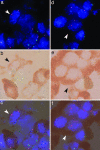Maternal microchimerism in peripheral blood in type 1 diabetes and pancreatic islet beta cell microchimerism
- PMID: 17244711
- PMCID: PMC1785262
- DOI: 10.1073/pnas.0606169104
Maternal microchimerism in peripheral blood in type 1 diabetes and pancreatic islet beta cell microchimerism
Abstract
Maternal cells have recently been found in the circulation and tissues of mothers' immune-competent children, including in adult life, and is referred to as maternal microchimerism (MMc). Whether MMc confers benefits during development or later in life or sometimes has adverse effects is unknown. Type 1 diabetes (T1D) is an autoimmune disease that primarily affects children and young adults. To identify and quantify MMc, we developed a panel of quantitative PCR assays targeting nontransmitted, nonshared maternal-specific HLA alleles. MMc was assayed in peripheral blood from 172 individuals, 94 with T1D, 54 unaffected siblings, and 24 unrelated healthy subjects. MMc levels, expressed as the genome equivalent per 100,000 proband cells, were significantly higher in T1D patients than unaffected siblings and healthy subjects. Medians and ranges, respectively, were 0.09 (0-530), 0 (0-153), and 0 (0-7.9). Differences between groups were evident irrespective of HLA genotypes. However, for patients with the T1D-associated DQB1*0302-DRB1*04 haplotype, MMc was found more often when the haplotype was paternally (70%) rather than maternally transmitted (14%). In other studies, we looked for female islet beta cells in four male pancreases from autopsies, one from a T1D patient, employing FISH for X and Y chromosomes with concomitant CD45 and beta cell insulin staining. Female islet beta cells (presumed maternal) formed 0.39-0.96% of the total, whereas female hematopoietic cells were very rare. Thus, T1D patients have higher levels of MMc in their circulation than unaffected siblings and healthy individuals, and MMc contributes to islet beta cells in a mother's progeny.
Conflict of interest statement
The authors declare no conflict of interest.
Figures


Similar articles
-
Maternal microchimerism in cord blood and risk of childhood-onset type 1 diabetes.Pediatr Diabetes. 2019 Sep;20(6):728-735. doi: 10.1111/pedi.12875. Epub 2019 Jun 19. Pediatr Diabetes. 2019. PMID: 31173445
-
Low prevalence of maternal microchimerism in peripheral blood of Japanese children with type 1 diabetes.Diabet Med. 2020 Dec;37(12):2131-2135. doi: 10.1111/dme.14221. Epub 2020 Jan 7. Diabet Med. 2020. PMID: 31872455
-
Maternal microchimerism: increased in the insulin positive compartment of type 1 diabetes pancreas but not in infiltrating immune cells or replicating islet cells.PLoS One. 2014 Jan 31;9(1):e86985. doi: 10.1371/journal.pone.0086985. eCollection 2014. PLoS One. 2014. PMID: 24498006 Free PMC article.
-
Microchimerism in type 1 diabetes.Curr Diab Rep. 2009 Apr;9(2):125-9. doi: 10.1007/s11892-009-0022-9. Curr Diab Rep. 2009. PMID: 19323957 Review.
-
The otherness of self: microchimerism in health and disease.Trends Immunol. 2012 Aug;33(8):421-7. doi: 10.1016/j.it.2012.03.002. Epub 2012 May 19. Trends Immunol. 2012. PMID: 22609148 Free PMC article. Review.
Cited by
-
Indirect evidence that maternal microchimerism in cord blood mediates a graft-versus-leukemia effect in cord blood transplantation.Proc Natl Acad Sci U S A. 2012 Feb 14;109(7):2509-14. doi: 10.1073/pnas.1119541109. Epub 2012 Jan 9. Proc Natl Acad Sci U S A. 2012. PMID: 22232664 Free PMC article.
-
Pregnancy-induced transfer of pathogen-specific T cells from mother to fetus in mice.EMBO Rep. 2023 Oct 9;24(10):e56829. doi: 10.15252/embr.202356829. Epub 2023 Aug 23. EMBO Rep. 2023. PMID: 37610043 Free PMC article.
-
Parity and HLA alleles in risk of rheumatoid arthritis.Chimerism. 2011 Jan;2(1):11-5. doi: 10.4161/chim.2.1.15424. Chimerism. 2011. PMID: 21547030 Free PMC article.
-
Parental transmission of HLA-DRB1*15 in multiple sclerosis.Hum Genet. 2008 Jan;122(6):661-3. doi: 10.1007/s00439-007-0442-z. Epub 2007 Oct 31. Hum Genet. 2008. PMID: 17972102
-
Vertically transferred maternal immune cells promote neonatal immunity against early life infections.Nat Commun. 2021 Aug 4;12(1):4706. doi: 10.1038/s41467-021-24719-z. Nat Commun. 2021. PMID: 34349112 Free PMC article.
References
-
- Hall J, Lingenfelter P, Adams SL, Lasser D, Hansen JA, Bean MA. Blood. 1995;86:2829–2832. - PubMed
-
- Lo DYM, Lo ES, Watson N, Noakes L, Sargent IL, Thilaganathan B, Wainscoat JS. Blood. 1996;88:4390–4395. - PubMed
-
- Petit T, Gluckman E, Carosella E, Brossard Y, Brison O, Socie G. Exp Hematol. 1995;23:1601–1605. - PubMed
-
- Petit T, Dommergues M, Socie G, Dumez Y, Gluckman E, Brison O. Br J Hematol. 1997;100:767–771. - PubMed
-
- Lo ESF, Lo YMD, Hjelm NM, Thilaganathan B. Br J Hematol. 1998;100:605–606. - PubMed
Publication types
MeSH terms
Substances
Grants and funding
LinkOut - more resources
Full Text Sources
Other Literature Sources
Medical
Research Materials
Miscellaneous

